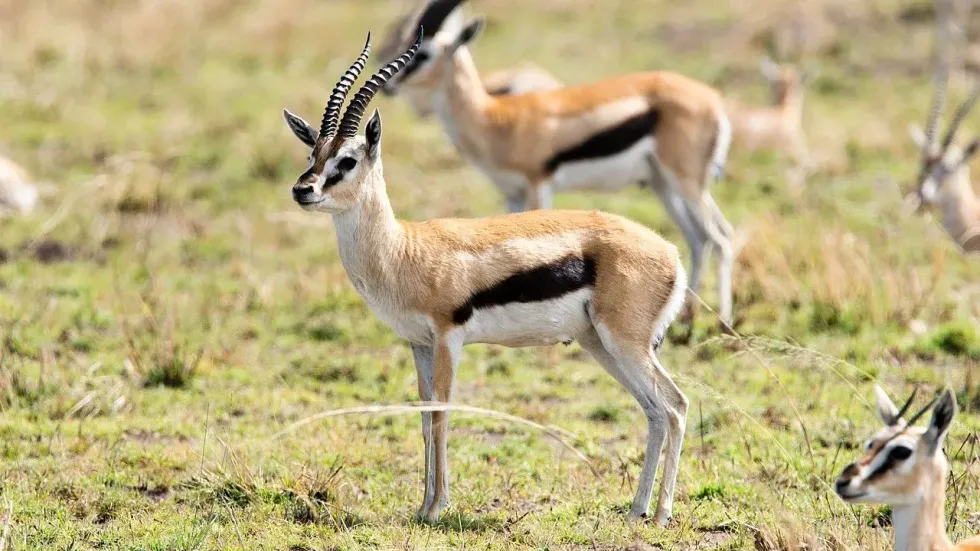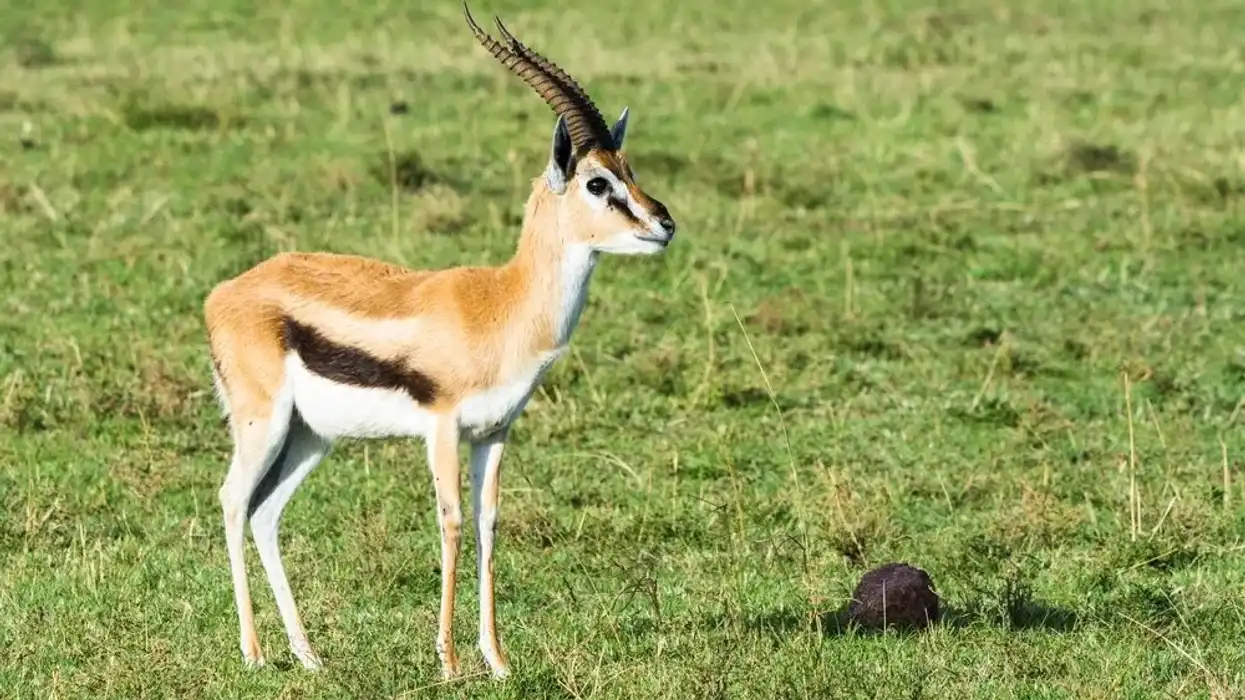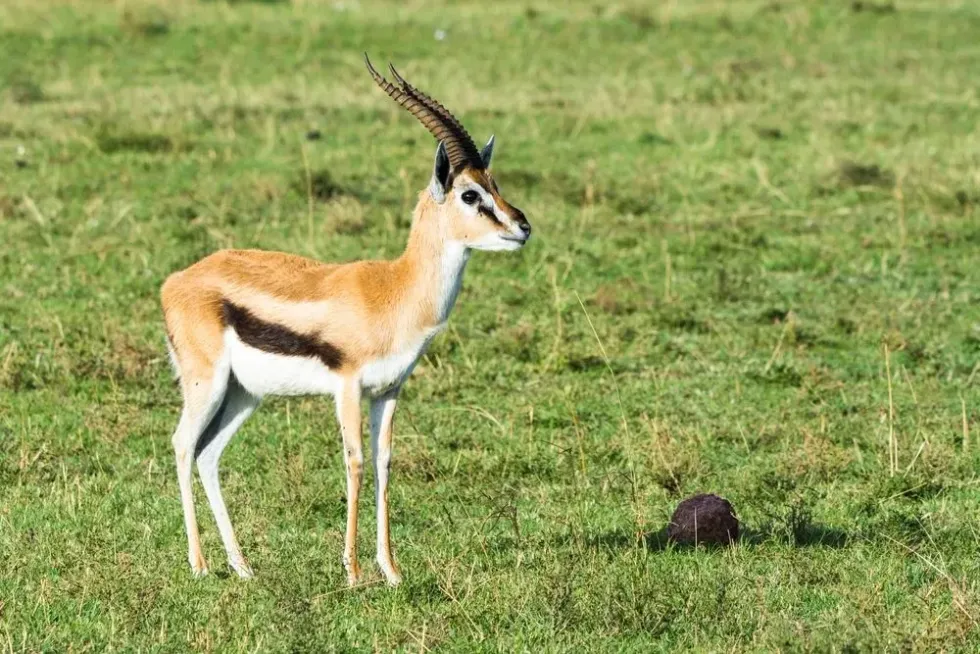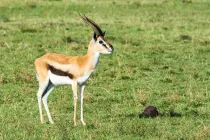Fun Thomson's Gazelle Facts For Kids
The Thomson's gazelle was named after Joseph Thomson, a British geologist and explorer. It is the most commonly found gazelle in eastern Africa.
The scientific name of this mammal, famous for its black stripes, is Eudorcas thomsonii, and it is more commonly known as the gazella. Thomson's gazelle is the fourth-fastest land animal in the world and the life span of an average Thomson's gazelle, living in the wild in the eastern African plains, is 10-15 years.
The territories of Thomson's gazelle include the eastern African areas of Masai Mara in Kenya and the Serengeti and Ngorongoro in Tanzania.
While the species has not been classified as endangered, their population has been reducing in number. Some prominent threats to their habitat are the rapid growth of the tourism industry, the development of roads, and industrialization.
The face of Thomson's gazelle is famously identified by white rings around the eyes of the species. It also has dark brown eyes that extend from the nose to the horns of both males and females.
Like several other species, the male gazelle has longer and bigger horns than the female gazelle. The body of Thomson's gazelle also has a characteristic black stripe stretching from the stomach to the hind legs.
The gestation period of females is six months long and births usually take place during or after the rainy season. After birth, females are known to hide their babies in the grasslands to protect them.
Thomson's gazelle babies are known as fawns. On average, a female Thomson's gazelle gives birth twice a year.
The Thomson's gazelle’s diet consists primarily of foliage from bushes in the dry season, and fresh grass during the rainy season. They travel in herds and meet with larger ungulates like zebras and wildebeests to feed.
Primary gazelle predators are cheetahs, leopards, and lions, as these animals tend to outrun the gazelle. Baby Thomson's gazelles (fawns) are often preyed upon by crocodiles, jackals, and baboons.
You can also check out our fact files on the scimitar oryx and the spiral-horned antelope!
Thomson's Gazelle Interesting Facts
What type of animal is a Thomson's gazelle?
Eudorcas thomsonii is the scientific name of Thomson's gazelle and this animal is a mammal. These animals belong to the Antilopinae subfamily, which includes animals such as blackbucks and springboks. This subfamily belongs to the Bovidae class, which comprises cloven-hoofed animals such as the water buffalo, the bison, the wildebeest, and goats.
What class of animal does a Thomson's gazelle belong to?
The Thomson’s gazelle is a mammal. These animals give birth to gazelle fawns at the end of a six-month-long gestation period. They also nurse their young, like other mammals. The Thomson's gazelle scientific name is Eudorcas thomsonii.
How many Thomson's gazelles are there in the world?
It is estimated that the global Thomson's gazelle population is approximately 207,700. These few remaining animals from the species can be found in the Masai Mara region of Kenya and in the Serengeti and Ngorongoro regions in Tanzania. Some Thomson's gazelles can also be found in zoos around the world, including the Serengeti Thomson's gazelle.
The Thomson’s gazelle has been classified as a Near Threatened species by the IUCN Red List. Rapid development and industrialization have led to the encroachment of their habitat and they have drastically reduced in number since the '90s.
Where does a Thomson's gazelle live?
Thomson's gazelles are found living in the plains of east Africa, particularly in savannas and grasslands. A population of gazelles can be found in the Masai Mara region of Kenya and in the Serengeti and Ngorongoro regions in Tanzania.
What is a Thomson's gazelle's habitat?
These animals can most commonly be found in savannas and grasslands, particularly in the plains of east Africa. This mammal prefers areas with short grasses that are favorable for feeding in the dry season.
Sometimes, they travel in herds and move to areas with taller grasses, as they eat wet grass in the rainy season. In areas with tall grasses, these animals depend on larger ungulates like wildebeests and zebras to cut through the grasses.
Who do Thomson's gazelles live with?
The Thomson’s gazelle lives in herds, which consist primarily of females and fawns. Males live alone and mark their breeding areas and territories during the rainy season. Males use their horns to dig into the soil and throw dirt onto an area with grass or bushes.
Males are combative and do not allow others into their territory. However, the territories of two males may share borders. Often, they fight with each other to chase intruders away from their marked range areas.
Males try to mate with individual female gazelles from passing groups. Female Thomson's gazelles tend to live in packs.
They move in herds, but only enter the territories of males. They are able to identify a Thomson's male gazelle by scent. When Thompson's gazelle fawns grow a few months old, the mother and the young fawn both become part of a herd.
How long does a Thomson's gazelle live?
The Thomson’s gazelle can live for 10-15 years in the wild. They are common prey for predators such as cheetahs and leopards, but they are often able to ward these predators off by living in groups.
How do they reproduce?
Breeding and reproduction among these gazelles happen as a result of males and females mating. Male Thomson's gazelles pick up the scents of female Thomson's gazelles and decide whether to mate with them.
Females carry children for six months, giving birth in the rainy season. These ungulates give birth twice a year, resulting in between two and four children every year in the wild. The fawn will stay close to the mother within the first six hours after birth, but with time, they separate and the fawn lives on its own.
The mother then visits only to nurse the fawn. She also visits to protect the fawn from any predators such as a baboon, crocodile, or jackal.
What is their conservation status?
The population of the Thomson’s gazelle has drastically reduced in the last two decades. These gazelles are listed as a Near Threatened species by the IUCN Red List.
They are the unfortunate victims of a loss of habitat due to development, hunting, and farming expansion.
They are largely restricted to the plains of eastern Africa, but sadly areas in Kenya and the Serengeti in Tanzania, are being converted to farmland, encroaching on the habitats of Thomson’s gazelles. As a result, they are often left without spaces to inhabit, and their numbers have reduced over the years.
Thomson's Gazelle Fun Facts
What do Thomson's gazelles look like?
The face of a Thomson's gazelle is famously identified by white rings around the eyes of the species. It also has dark brown eyes that extend from the nose to the horns of both males and females.
Like several other species, the male gazelle has longer and bigger horns than the female gazelle, these are found on a Thomson's gazelle skull. The body of a Thomson's gazelle also has a characteristic black stripe stretching from the stomach to the hind legs.
Male Thomson's gazelles weigh in the range between 44-77 lb (19.9-34.9 kg), while female Thomson's gazelles weigh between 33-55 lb (14.9-24.9 kg). These wildlife gazelles are roughly 26 in (66 cm) tall.

How cute are they?
A Thomson's gazelle fawn is particularly cute and sweet to look at within the first six months after birth. As they are among the smaller animals of the African savanna, they have a softer appearance.
In comparison with other herbivores in the region, they are particularly adorable to look at. In comparison with many carnivores in the territories, they are smaller and hence, seem more approachable.
How do they communicate?
Thomson’s gazelles primarily communicate visually. When found in groups, they make small, coordinated hopping motions. They raise their front legs and move their hind legs forward to indicate that there is danger nearby and that the herd must flee. For the purposes of mating and reproduction, male gazelles mark breeding territories with their scents to attract mature females.
How big is a Thomson's gazelle?
The Thomson’s gazelle is a smaller animal than most others from the Bovidae family, including the oxen, the wildebeest, and goats. The average Thomson's gazelle height is roughly 26 in (66 cm).
Thomson’s gazelles are roughly the same size as their predator, African leopards, though they are much smaller than the cheetah, making them relatively easy prey.
They are only a little smaller than a hyena, and can often outrun that species. Though the young are significantly smaller than baboons, a mother hyena is able to scare away predators using her horns.
How fast can a Thomson's gazelle run?
The top Thomson’s gazelle speed is as fast as 60 mph (96.5 kph), and its average speed is 50 mph (80.4 kph).
How much does a Thomson's gazelle weigh?
Average male Thomson's gazelles weigh in the range between 44-77 lb (19.9-34.9 kg), while female Thomson's gazelles weigh in the range between 33-55 lb (14.9-24.9 kg).
What are the male and female names of the species?
Male and female Thomson's gazelles do not have separate names. They are just called Thomson's gazelles.
What would you call a baby Thomson's gazelle?
A baby Thomson's gazelle is called a fawn.
What do they eat?
The Thomson's gazelle diet consists of shorter grasses, foliage, and bushes in the dry season. In the rainy season, their diet consists of wet, taller grasses.
To find these, they travel with larger ungulates such as the zebra and wildebeest. These larger species can cut through the taller grasses, which is helpful to the gazelles.
The Thomson's gazelle is unable to do this owing to its small size. They meet most of their water needs through the vegetation they eat and only need to drink very little water, but when it comes to a Grant gazelle vs Thomson's gazelle comparison, their water requirement is higher.
Are they aggressive?
No, the Thomson’s gazelle is a peaceful animal, only displaying aggressive behavior to protect its herd or to protect its fawn from a predator. This happens in particular when predators such as baboons attack a young fawn and female gazelles fend them off using their horns.
Would they make a good pet?
Keeping in mind their quiet and tame nature, Thomson’s gazelle animals might seem like a good pet. They are, however, wild animals and should be allowed to remain in their natural habitat.
The Thomson's gazelle is also found in some zoos around the world, such as Cincinnati Zoo. They are friendly and do not tend to fight with other animals.
Did you know...
In 2016, a Thomson's gazelle was featured in the Disney movie 'Zootopia'. The character was a performer and singer and she was voiced by pop star Shakira. This film made gazelles well known among all Disney fans!
The Thomson's gazelle is also said to have inspired the fashion designer Alexander McQueen for one of his clothing lines.
These gazelles sleep for five minutes at a time in short periods, adding up to about one hour each day.
How did Thomson's gazelle get its name?
Thomson’s gazelles got their name from explorer Joseph Thomson, who was one of the first people to discover them.
How do a Thomson's gazelle and a cheetah differ in speed?
Thomson's gazelle can reach speeds of 60 mph (96.5 kph). Cheetahs are the chief predator of Thomson’s gazelle and they can reach up to 70 mph (112.6 kph), making Thomson’s gazelle the fourth-fastest land animal.
Here at Kidadl, we have carefully created lots of interesting family-friendly animal facts for everyone to discover! For more relatable content, check out these Alpine ibex facts and addax facts for kids.
You can even occupy yourself at home by coloring in one of our free printable Thomson's gazelle coloring pages.
We Want Your Photos!
More for You
See All
Doctorate specializing in Veterinary Medicine

Oluniyi AkandeDoctorate specializing in Veterinary Medicine
With an accomplished background as a Veterinarian, SEO content writer, and public speaker, Oluniyi brings a wealth of skills and experience to his work. Holding a Doctor of Veterinary Medicine degree from the University of Ibadan, he provides exceptional consulting services to pet owners, animal farms, and agricultural establishments. Oluniyi's impressive writing career spans over five years, during which he has produced over 5000 high-quality short- and long-form pieces of content. His versatility shines through as he tackles a diverse array of topics, including pets, real estate, sports, games, technology, landscaping, healthcare, cosmetics, personal loans, debt management, construction, and agriculture.
Disclaimer
1) Kidadl is independent and to make our service free to you the reader we are supported by advertising. We hope you love our recommendations for products and services! What we suggest is selected independently by the Kidadl team. If you purchase using the Buy Now button we may earn a small commission. This does not influence our choices. Prices are correct and items are available at the time the article was published but we cannot guarantee that on the time of reading. Please note that Kidadl is a participant in the Amazon Services LLC Associates Program, an affiliate advertising program designed to provide a means for sites to earn advertising fees by advertising and linking to Amazon. We also link to other websites, but are not responsible for their content.
2) At Kidadl, we strive to recommend the very best activities and events. We will always aim to give you accurate information at the date of publication - however, information does change, so it’s important you do your own research, double-check and make the decision that is right for your family. We recognise that not all activities and ideas are appropriate for all children and families or in all circumstances. Our recommended activities are based on age but these are a guide. We recommend that these ideas are used as inspiration, that ideas are undertaken with appropriate adult supervision, and that each adult uses their own discretion and knowledge of their children to consider the safety and suitability. Kidadl cannot accept liability for the execution of these ideas, and parental supervision is advised at all times, as safety is paramount. Anyone using the information provided by Kidadl does so at their own risk and we can not accept liability if things go wrong.
3) Because we are an educational resource, we have quotes and facts about a range of historical and modern figures. We do not endorse the actions of or rhetoric of all the people included in these collections, but we think they are important for growing minds to learn about under the guidance of parents or guardians.







